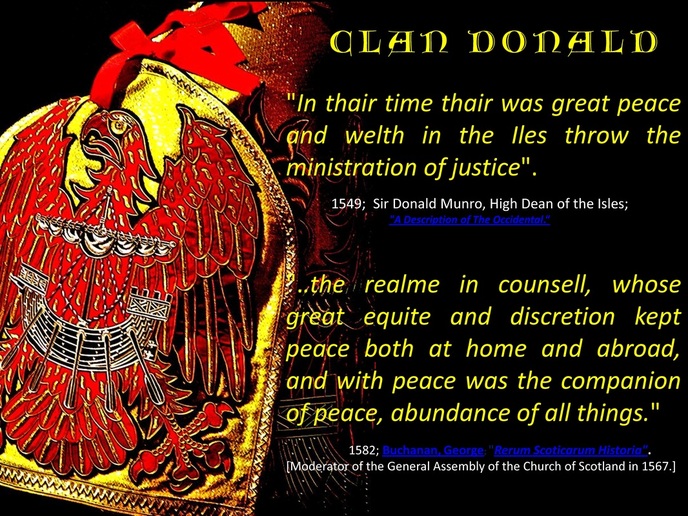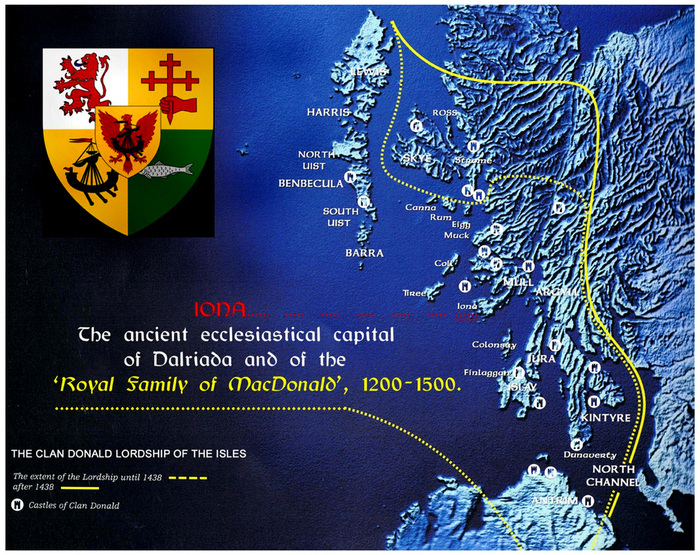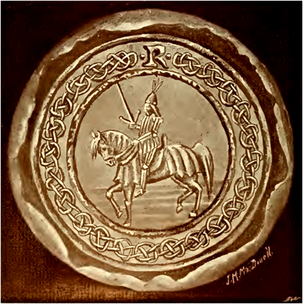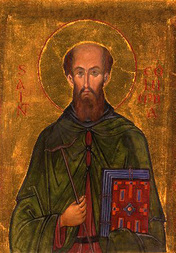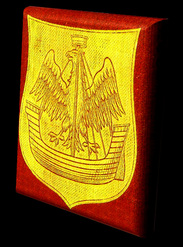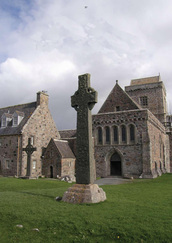CLAN DONALD AND IONA ABBEY Page next
|
'The story of Clan Donald is at the heart of the history of Gaeldom. For over 300 years, political and cultural harmony flourished in the Sea Kingdom of the west. This kingdom, the Lordship of the Isles, encompassed the western mainland and the Hebrides.
Clan Donald was at its head. |
The Lordship was very different from the rest of Scotland in its government and culture. An elected council governed the isles. It "decernt, decretit and gave suits furth upon all debaitable matters according to the laws made by Ranald McSomhakle ......King of the Occident Isles'.
[The Museum of the Isles; Armadale, Isle of Skye.] |
The "Royal Family of MacDonald formerly Kings
of the Western parts of Scotland and the Isles.”
(W. Sacherverell Esq., Governor of Mann, 1688 :- link to p.135; 1702 Ed.
1859 Ed. 'An account of the Isle of Man : etc ... with a voyage to I-Columb-Kill.')
of the Western parts of Scotland and the Isles.”
(W. Sacherverell Esq., Governor of Mann, 1688 :- link to p.135; 1702 Ed.
1859 Ed. 'An account of the Isle of Man : etc ... with a voyage to I-Columb-Kill.')
IONA ABBEY (and Nunnery)
'The island of Iona', off the west coast of Scotland, is the symbolic center of Scottish Christianity. Through 1400 years of history its fortunes have fluctuated, from its heights as one of the greatest centers of learning in Dark Age Europe, to its lows as a crumbling ruin. Many of the kings of Scotland, Ireland, and even of the Vikings, were buried there. Some of the most famous Kings of Alba, from Kenneth MacAlpin to MacBeth, made their final journey there - across the sound to Iona, onto the harbour, and up the Street of the Dead to the burial ground, the Relig Oran. [BBC].
VOL III; pps 48, 49; 1897. [2.] Fawcett, Professor Richard, OBE, PhD; “SCOTTISH MEDIEVAL
CHURCHES.” Historic Buildings and Monuments Directorate, Edinburgh. 1985. ]
KING REGINALD (d. 1207) AND HIS IMMEDIATE HEIRS THE CLAN DONALD LORDS OF THE ISLES, WERE THE PRINCIPAL FINANCIERS AND BUILDERS OF IONA ABBEY AND NUNNERY. [save/open slide presentation]
IT WAS NOT, AS COMMONLY PORTRAYED DESPITE ALL THE ABOVE, THE IONA ABBOTT ...... OR THE "MAC SOMERLEDS" ..... OR THE ROMAN CHURCH..... OR THE BENEDICTINE ORDER ... OR 'THE MONKS'. [save/open slide presentations]
"The patron has the subsidiary duty of building" (Trent, Sess. XXI, "de ref.", c. vii). ius patronatus - ipso jure : “A right of patronage comes into existence or is originally acquired by foundation, privilege, or prescription. Under foundation or fundatio in the broader sense is included the granting of the necessary means for the erection and maintenance of a benefice."
"Thus, granting that a church is necessary to a benefice, three things are requisite:
[WHAT IS A PATRON? I think we have a really big problem with today’s understanding of “patron”. It is a term dramatically altered from ecclesiastical medieval times and today has a multitude of different, lesser meanings. I’ve done some sampling, and if 100 ordinary Iona visitors were asked what is the patron of an abbey, I would wager that 75-90 would say one of these {from Oxford Dictionary meanings} :- a distinguished person invited to hold an office of honour there so that it might benefit from his/her position, influence; a person who gives support, money, custom {stone monuments}, protection; can appoint to offices; advocate, defender; even a person who frequents there; a patron saint.
Even most church literate people would only think it means : “holder of a right of presentation to an ecclesiastical benefice”. The majority do not know the full medieval meaning includes, eg, “the granting of the necessary means for the erection and maintenance of a benefice; the erection of the church at one's private expense (aedificatio).”
And ask the same 100 Iona visitors, who built the abbey, and I bet 90-99 say: “The monks built the abbey”! Or the Abbot!]
Kings were the principal Abbey builders, not Abbots; they are the King’s Master Masons or Church-Wrights, not the Abbotts. It is such a difficult task to overcome the most ubiquitous misconstruction of the economic arrangements for medieval ecclesiastical infrastructure and financing:- ie, "The monks built the Abbey!”
[The medieval mason was not a monk but a highly skilled lay craftsman who combined the roles of architect, builder, craftsman, designer and engineer." BBC; Feb 2011. ]
But why is it such a problematic concept to grasp, or accept, for the western isles when the paradigm is pris pour acquis in the rest of Scotland? A few equivalent examples of many are :-
1. "King Edgar of Scotland had granted the land of Coldingham to the Church of Durham in
1098, and a church was constructed by him and presented in 1100.
2. (St) Margaret, mother of David I, was provided with a group of Benedictine monks by the
Archbishop of Canterbury “for the church she built at Dunfermline.” "It was King David I
who rebuilt the Abbey as a much larger and more magnificent structure."
3. "Building of the (Holyrood) Abbey Church began shortly after its foundation in 1128
by David I for the Augustinian Canons”.
4. Duncan, Earl of Carrick “superintended the erection of the structure” - Crossraguel Abbey,
Ayrshire; c1244-50.
A partial explanation is :- [A] "Indeed, the contribution of the native elements of Scotland in this respect remains an almost unwritten Chapter in the ecclesiastical history of Scotland” (MacDonald RA; 1995. "Scoto-Norse Kings and the Reformed Religious Orders"); and..
[B] Dr. Geoffrey Keating's Preface, 1861 . An extract:- "What was worthy or commendable in the Irish [read Gaelic] nobility and gentry, they pass over. They take no notice of their piety, learning, and courage, of their charitable disposition to build churches and religious houses, or of the great privileges and endowments they conferred and settled upon them." [NB: This is little different to what has happened to much of the history of the Western Highlands and Islands of Scotland.]
TO ONLY SAY THAT REGINALD FOUNDED IONA ABBEY AND THE LORDS OF THE ISLES (UNNAMED) WERE GENEROUS BENEFACTORS THROUGHOUT OR PATRONS IS AS COMPLETELY INADEQUATE AND INSUFFICIENT AS SAYING THAT THE BENEDICTINE MONASTERY, NOW "WEST MINSTER ABBEY", WAS FOUNDED BY THE "BOY KING" EDGAR, c.960, AND THAT KING EDWARD THE CONFESSOR, 11TH CENTURY, AND HENRY III, 13TH CENTURY WERE JUST GENEROUS BENEFACTORS OR PATRONS.
THIS WOULD NEVER BE TOLERATED BY ANYONE, BECAUSE IN FACT THEY EACH FINANCED AND REBUILT 'WEST MINSTER' ON A MUCH GRANDER SCALE, STYLE AND ENHANCED STANDARD - TWO CENTURIES APART. HENRY III REBUILT ALMOST THE ENTIRE ABBEY COSTING HIM MORE THAN £41,000 - THE 2ND MOST EXPENSIVE BUILDING PROJECT IN MEDIEVAL ENGLAND. [1] THE OFFERINGS OF PILGRIMS TO THE MOST FABULOUS GOLD PLATED AND JEWEL ENCRUSTED SHRINE OF ST EDWARD THE CONFESSOR (OR FOR INDULGENCES) DID NOT FUND THIS REBUILDING!
EQUALLY, A SIMILAR INADEQUATE, FAR FROM COMPREHENSIVE INTERPRETATION (ALBEIT SMALLER SCALE) SHOULD NOT BE TOLERATED CONCERNING THE FINANCING, SUPERINTENDING AND ORIGINAL CONSTRUCTION OF IONA ABBEY AND THE FINANCING AND BUILDING OF THE 15TH CENTURY CATHEDRAL OF THE ISLES BY THE FOUNDER'S HEIRS, THE CLAN DONALD LORDS OF THE ISLES.
'The island of Iona', off the west coast of Scotland, is the symbolic center of Scottish Christianity. Through 1400 years of history its fortunes have fluctuated, from its heights as one of the greatest centers of learning in Dark Age Europe, to its lows as a crumbling ruin. Many of the kings of Scotland, Ireland, and even of the Vikings, were buried there. Some of the most famous Kings of Alba, from Kenneth MacAlpin to MacBeth, made their final journey there - across the sound to Iona, onto the harbour, and up the Street of the Dead to the burial ground, the Relig Oran. [BBC].
- 1203 : Reginald, King of the Isles, not only founded medieval Iona abbey, being the principal endower of the "Mac Somerled" lands to it (primary creditor; controlling interest), but also... "Reginald, the son of Somerled, undertook the rebuilding of the [Iona] monastery on a larger scale”...(with) "the likelihood that Reginald's masons were drawn from Ireland.” (ie, The Derry O'Brolchains - the Lordship’s long serving, hereditary chief masons, artificers, church wrights and personal secretaries.)
VOL III; pps 48, 49; 1897. [2.] Fawcett, Professor Richard, OBE, PhD; “SCOTTISH MEDIEVAL
CHURCHES.” Historic Buildings and Monuments Directorate, Edinburgh. 1985. ]
- King Reginald, “The Lord of The Isles, chose to place the medieval monastery in a position that showed respect for the earlier sacred buildings.”
[Historic Scotland.]
- King Reginald, “opulent, and the most distinguished of the Gaill or the Gael for prosperity, sway of generosity and feat of arms" was “Rex Insularum - Dominus de Ergile et Kyntyre; Dominus de Inchegal”.
[known titles he used; WDH Sellar, 2000; current Lord Lyon]. - “It was the founder of a house and his heirs who provided the impetus to build or rebuild, who might contribute ideas, and who furnished resources to finance the project” (Monastic and Religious Orders; p.152; Burton, J., 1994.)
- "In 1200 AD, Raghnall, son of Somerled, virtual King of the Isles, brought in the Benedictine Order and built the great abbey.”
The BBC (the grammar used:- they clearly mean Reginald was the principal builder).
- "Iona was engaged in building its Benedictine abbey in the first decade of the century, under the protection of Reginald, son of Somerled."
(Power, Rosemary (2005); "Meeting in Norway: Norse-Gaelic relations in the kingdom of Man and the Isles, 1090–1270" (pdf), Saga-Book (Viking Society for Northern Research) 38 : 5–66.
NB : R Power does not say that anyone other than Reginald was the founder of Iona Abbey and to infer otherwise is misreading or twisting her words (and this is clear from her quote above). All that Rosemary clearly says is the large foundation endowments from all over the isles "must have involved the agreement" of the wider Mac Somerled family (p.29), ie, they were convinced or co-opted by the primary founder, Reginald, to make a contribution of some land.)
KING REGINALD (d. 1207) AND HIS IMMEDIATE HEIRS THE CLAN DONALD LORDS OF THE ISLES, WERE THE PRINCIPAL FINANCIERS AND BUILDERS OF IONA ABBEY AND NUNNERY. [save/open slide presentation]
IT WAS NOT, AS COMMONLY PORTRAYED DESPITE ALL THE ABOVE, THE IONA ABBOTT ...... OR THE "MAC SOMERLEDS" ..... OR THE ROMAN CHURCH..... OR THE BENEDICTINE ORDER ... OR 'THE MONKS'. [save/open slide presentations]
"The patron has the subsidiary duty of building" (Trent, Sess. XXI, "de ref.", c. vii). ius patronatus - ipso jure : “A right of patronage comes into existence or is originally acquired by foundation, privilege, or prescription. Under foundation or fundatio in the broader sense is included the granting of the necessary means for the erection and maintenance of a benefice."
"Thus, granting that a church is necessary to a benefice, three things are requisite:
- FOUNDATION - the assignment of land, for the site only
- BUILDING - the erection of the church at one's private expense (aedificatio);
- FUNDING - and the granting of the means necessary for the support of the church and beneficiaries (dotatio)." [endowment of much extra land to provide guaranteed recurring income- ‘rents’, tithes, etc]
[WHAT IS A PATRON? I think we have a really big problem with today’s understanding of “patron”. It is a term dramatically altered from ecclesiastical medieval times and today has a multitude of different, lesser meanings. I’ve done some sampling, and if 100 ordinary Iona visitors were asked what is the patron of an abbey, I would wager that 75-90 would say one of these {from Oxford Dictionary meanings} :- a distinguished person invited to hold an office of honour there so that it might benefit from his/her position, influence; a person who gives support, money, custom {stone monuments}, protection; can appoint to offices; advocate, defender; even a person who frequents there; a patron saint.
Even most church literate people would only think it means : “holder of a right of presentation to an ecclesiastical benefice”. The majority do not know the full medieval meaning includes, eg, “the granting of the necessary means for the erection and maintenance of a benefice; the erection of the church at one's private expense (aedificatio).”
And ask the same 100 Iona visitors, who built the abbey, and I bet 90-99 say: “The monks built the abbey”! Or the Abbot!]
Kings were the principal Abbey builders, not Abbots; they are the King’s Master Masons or Church-Wrights, not the Abbotts. It is such a difficult task to overcome the most ubiquitous misconstruction of the economic arrangements for medieval ecclesiastical infrastructure and financing:- ie, "The monks built the Abbey!”
[The medieval mason was not a monk but a highly skilled lay craftsman who combined the roles of architect, builder, craftsman, designer and engineer." BBC; Feb 2011. ]
But why is it such a problematic concept to grasp, or accept, for the western isles when the paradigm is pris pour acquis in the rest of Scotland? A few equivalent examples of many are :-
1. "King Edgar of Scotland had granted the land of Coldingham to the Church of Durham in
1098, and a church was constructed by him and presented in 1100.
2. (St) Margaret, mother of David I, was provided with a group of Benedictine monks by the
Archbishop of Canterbury “for the church she built at Dunfermline.” "It was King David I
who rebuilt the Abbey as a much larger and more magnificent structure."
3. "Building of the (Holyrood) Abbey Church began shortly after its foundation in 1128
by David I for the Augustinian Canons”.
4. Duncan, Earl of Carrick “superintended the erection of the structure” - Crossraguel Abbey,
Ayrshire; c1244-50.
A partial explanation is :- [A] "Indeed, the contribution of the native elements of Scotland in this respect remains an almost unwritten Chapter in the ecclesiastical history of Scotland” (MacDonald RA; 1995. "Scoto-Norse Kings and the Reformed Religious Orders"); and..
[B] Dr. Geoffrey Keating's Preface, 1861 . An extract:- "What was worthy or commendable in the Irish [read Gaelic] nobility and gentry, they pass over. They take no notice of their piety, learning, and courage, of their charitable disposition to build churches and religious houses, or of the great privileges and endowments they conferred and settled upon them." [NB: This is little different to what has happened to much of the history of the Western Highlands and Islands of Scotland.]
TO ONLY SAY THAT REGINALD FOUNDED IONA ABBEY AND THE LORDS OF THE ISLES (UNNAMED) WERE GENEROUS BENEFACTORS THROUGHOUT OR PATRONS IS AS COMPLETELY INADEQUATE AND INSUFFICIENT AS SAYING THAT THE BENEDICTINE MONASTERY, NOW "WEST MINSTER ABBEY", WAS FOUNDED BY THE "BOY KING" EDGAR, c.960, AND THAT KING EDWARD THE CONFESSOR, 11TH CENTURY, AND HENRY III, 13TH CENTURY WERE JUST GENEROUS BENEFACTORS OR PATRONS.
THIS WOULD NEVER BE TOLERATED BY ANYONE, BECAUSE IN FACT THEY EACH FINANCED AND REBUILT 'WEST MINSTER' ON A MUCH GRANDER SCALE, STYLE AND ENHANCED STANDARD - TWO CENTURIES APART. HENRY III REBUILT ALMOST THE ENTIRE ABBEY COSTING HIM MORE THAN £41,000 - THE 2ND MOST EXPENSIVE BUILDING PROJECT IN MEDIEVAL ENGLAND. [1] THE OFFERINGS OF PILGRIMS TO THE MOST FABULOUS GOLD PLATED AND JEWEL ENCRUSTED SHRINE OF ST EDWARD THE CONFESSOR (OR FOR INDULGENCES) DID NOT FUND THIS REBUILDING!
EQUALLY, A SIMILAR INADEQUATE, FAR FROM COMPREHENSIVE INTERPRETATION (ALBEIT SMALLER SCALE) SHOULD NOT BE TOLERATED CONCERNING THE FINANCING, SUPERINTENDING AND ORIGINAL CONSTRUCTION OF IONA ABBEY AND THE FINANCING AND BUILDING OF THE 15TH CENTURY CATHEDRAL OF THE ISLES BY THE FOUNDER'S HEIRS, THE CLAN DONALD LORDS OF THE ISLES.
| not_the_benedictines_2.pdf | |
| File Size: | 2346 kb |
| File Type: | |
Footnotes. 1. Mortimer, Ian; "The Time Travellers Guide to medieval England", pps 21, 155; 2009. The most expensive was Edward III's almost total rebuild of Windsor Castle for more than £50,000.
